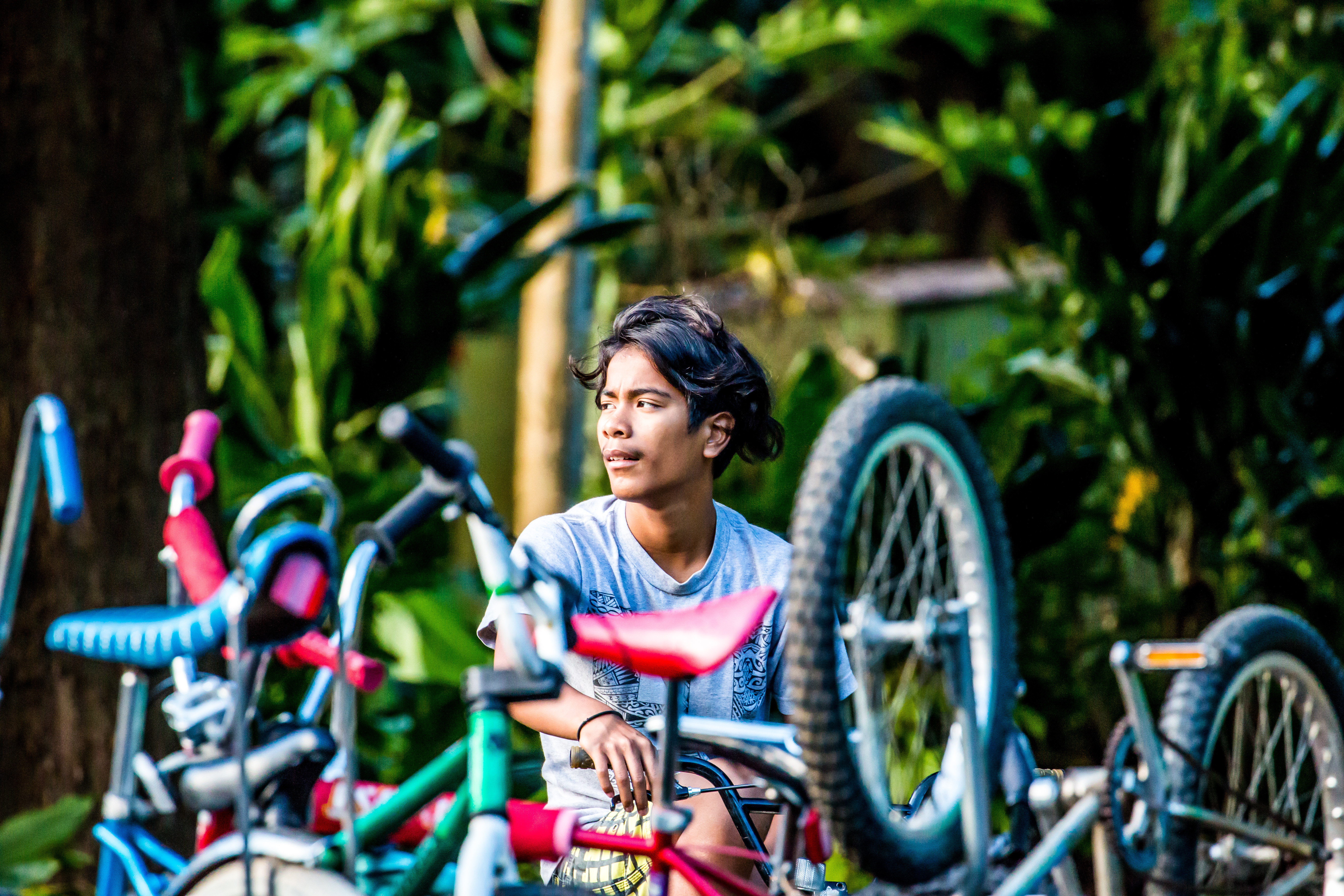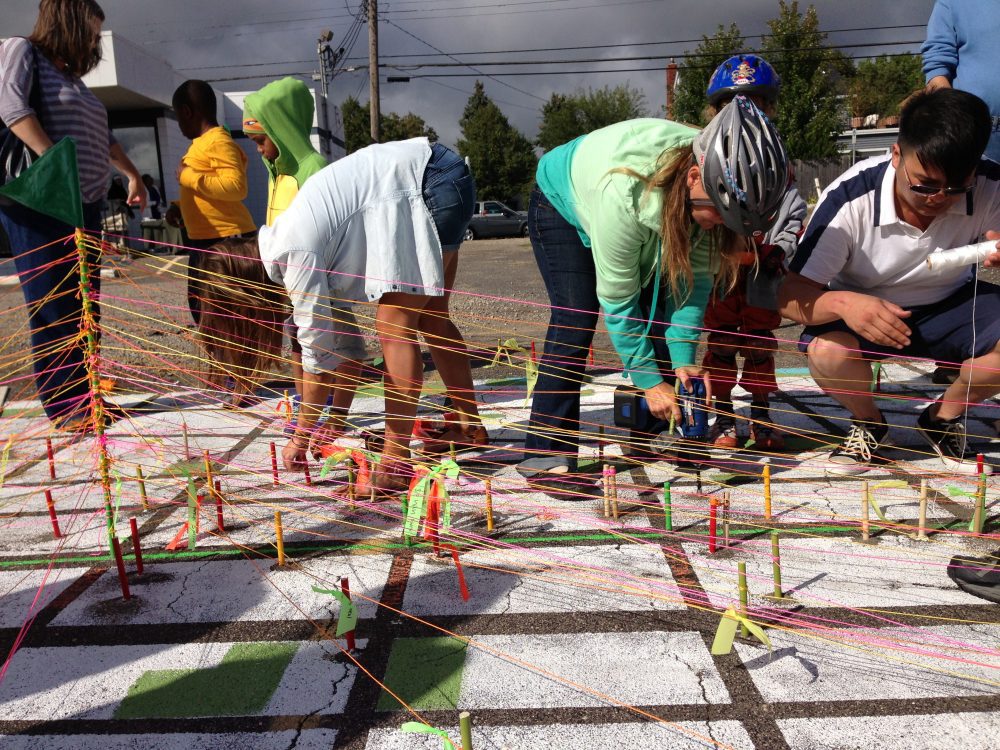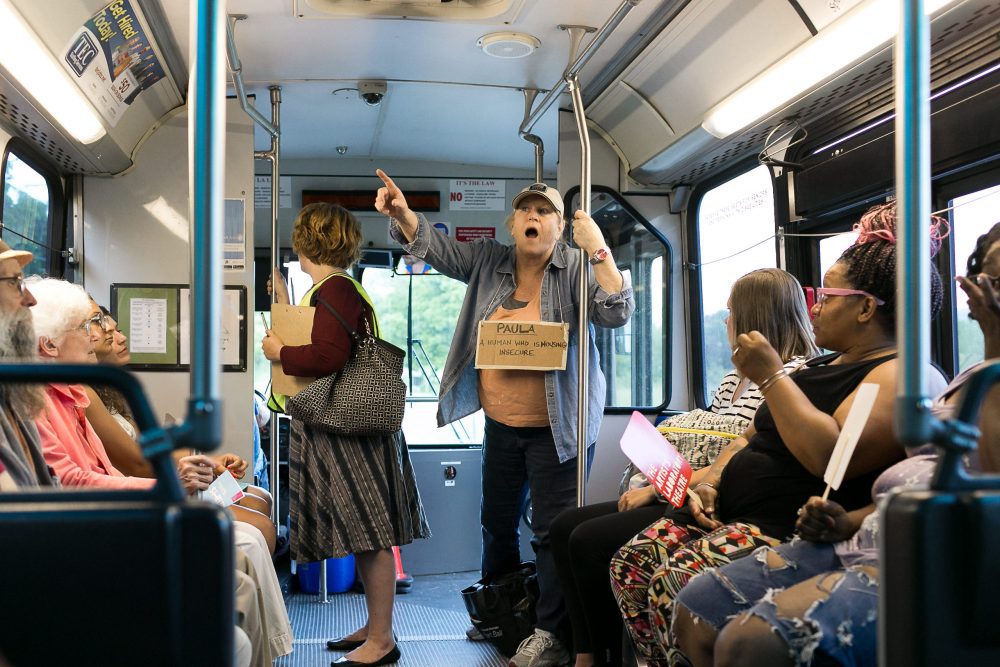
KVIBE, the Kalihi Valley Instructional Bike Exchange, is a bike shop that serves as a second home for many of the young men and boys of the community. Photo courtesy of KKV staff
“We need to give each other the space to grow, to be ourselves, to exercise our diversity. We need to give each other space so that we may both give and receive such beautiful things as ideas, openness, dignity, joy, healing, and inclusion.” — Max de Pree,
American businessman and writer
Can you think of a place where you felt safe, welcome, and supported? A place where you were accepted—inclusive of your faults, but more importantly, where your hidden talents have room to grow? A space may appear in your memory or imagination vividly, but for some, it may be hard to imagine a place that doesn’t yet exist. In a time when many communities face complex challenges like violence, substance misuse, and poverty, these spaces can help facilitate healing by offering residents a place to gather, connect, and thrive.
In the Kalihi Valley of Honolulu, Hawaii—where a majority of residents live below the poverty line—a bike shop serves as a second home for many of the young men and boys of the community. KVIBE, the Kalihi Valley Instructional Bike Exchange, was created in 2005 as part of a grant to promote physical activity in communities that experienced high rates of diabetes. Every year, young men and boys log around 9,000 service hours repairing roughly 4,000 bikes, and they have a chance to earn one for their work. In a community where young men are faced with poverty, loss of cultural identity, and low-educational attainment, KVIBE isn’t just about bike repair—it’s a space for reflection, healing, connection, and purpose.
“Healing spaces require vulnerability,” says Jeffrey Acido, an education and training specialist with KVIBE. “You can’t heal without being vulnerable.”
Every weekday at 3:30 p.m., young men and boys meet up at KVIBE to participate in culture circles before moving on to bikes. “We always start with what is your name, what is home to you, and then an ancestor,” Acido says. “Usually there’s a prompt. Bring an ancestor who taught you how to heal, bring an ancestor who taught you how to laugh . . . that ancestor can be living or not living, by blood, or a mentor or friend or neighbor, but bring that spirit in. That brings a certain type of intentionality to start any activity we have.”
For Acido, these circles embody the powerful ancestral history passed down to each young man and affirms their value as individuals: “Anyone who can say these things with confidence has love for themselves—this is mental wellbeing.”
Many times, cultivating healing spaces begins with a desire to find places of belonging, connection, trust, and safety to address what we call community trauma—trauma associated with exposure to violence, marginalization, poverty, substance misuse, and other issues. This trauma reverberates beyond affecting individuals to shaping a feeling of deterioration, risk, and disinvestment that can permeate a community as a whole, contributing to broken social networks, reinforcing isolation, and breeding hopelessness.
Informal healing spaces can serve as a gathering place for those who may be hesitant to seek help on their own and for community members who may not have directly experienced trauma, but are part of an environment where trauma is pervasive. Acido says that the actual physical space makes a difference in so far as the community members feel positive about the history and energy of the place, and it is designed and managed in a way that emphasizes what’s important to the community.
Rebuilding social networks, embracing the community’s cultural heritage, and creating opportunities for residents to participate in collective action to improve community conditions can help address the root causes of trauma and foster healing and resilience.
Prevention Institute—a national public health nonprofit headquartered in Oakland, California—works with communities across the country to create healing spaces like KVIBE. Some organizations have responded to their communities’ needs by identifying and creating spaces for residents to gather in support of one another through their participation in the Making Connections for Mental Health and Wellbeing Among Men and Boys initiative, coordinated by Prevention Institute and funded by the Movember Foundation.
Healing Spaces—Mental Health and Wellbeing
Take, for example, the City Heights neighborhood in San Diego, California—the second-largest community of East African refugees in the United States. Approximately 30,000 East African immigrants and refugees call City Heights home, and the neighborhood reflects the rich culture, food, and languages of people from Somalia, Sudan, South Sudan, Kenya, Uganda, Ethiopia, and Eritrea. But adjusting to a life in a new country is a challenge, one that in San Diego includes a shortage of safe and affordable housing and a lack of educational and economic opportunities. These challenges are compounded by traumatic experiences these refugees experienced in their home countries and the stigma attached to those who seek mental health support.

The Hub in San Diego offers a space for young men of East African descent to access culturally relevant resources, which encourages an atmosphere of brotherhood for coping with depression, social isolation, and experiences of trauma. Photo courtesy of Jill Hodges
Over the span of several years, between 2009 and 2016, a string of suicides among East African men and boys occurred in the City Heights area and underscored the urgent need for the community to focus on trauma and healing. For many residents, these losses spoke to a common experience of feeling isolated. “It’s different to feel alone here,” Jama Mohamed, a City Heights resident, said. “It’s a more individualized culture. Even brothers become strangers.”
Following these suicides, the United Women of East Africa Support Team (UWEAST) and its partners—the African Workforce, the Southern Sudanese Community Center, the Partnership for the Advancement of New Americans, and the Center for Community Health at the University of California, San Diego—decided to create a space for boys and young men of East African descent to be their full selves and honor their culture through language, sports, artistic expression, and cuisine. In this space, these young men have the opportunity to access culturally relevant resources such as East African retailers, mentors, and ancestral connections through the local community, which encourages an atmosphere of brotherhood for coping with depression, social isolation, and experiences of trauma. Nicknamed “the Hub,” this space brings together members of the East African community, including respected community members who serve as educators and counselors who share their personal journeys and stories.
It was through listening sessions at UWEAST that the boys and young men of the community began to communicate that they felt they had no place that felt safe and welcoming to gather. One of the young men born and raised in City Heights who attends the Hub describes it as “a safe haven” for him and other kids his age who have been exposed to multiple forms of violence. “I am forever grateful because if it wasn’t for UWEAST, I may have not been in the position I currently am in right now [as a college student].”
Abdiweli Haji, grant manager at UWEAST, describes the Hub as “kind of like a living room—people can walk in at anytime they want and it feels like home.” Located on the second floor of the United Women of East Africa Center, the space has comfortable couches, soft carpeting, and colorful art on the walls. There are also computer workstations, a television, video games, an area set up for small workshops, and an outdoor space for sports.
The Hub serves as a place where boys and young men are always welcome and know that they can find what they need, whether that’s someone to talk to or a peaceful place to unwind. Through events like basketball tournaments, open-mic nights, and skills-building workshops geared toward workforce readiness, the Hub holistically enhances healing and fosters a sense of well-being for young men and boys by connecting them to a broader community of fellow East Africans, and providing stability and consistency. Faith leaders often attend events, where East African food and music make the space feel familiar, and assure that cultural traditions are shared with younger generations.
Healing Spaces—A Resource for Veterans
In other places, healing spaces are created to address a need within an institution. That’s the case in Kankakee, Illinois, where Kankakee Community College (KCC) created a veterans’ resource center in partnership with their student veterans to help them connect with one another and transition from active-duty service to life on campus. Veterans have higher rates of PTSD, anxiety, and depression. According to the latest data from the Department of Veteran Affairs, veterans die by suicide at a rate one-and-a-half times greater than civilians. Adjusting from military life to civilian life presents veterans with challenges that merit population-specific approaches to spaces and activities.
Every semester, around 70 student veterans utilize and help operate the space within the KCC community. The resource center was designed by student veterans for student veterans, and provides a space for vets to engage with peers who share similar life experiences. The physical space itself takes into consideration factors like furniture placement—since some veterans don’t want to sit with their backs to the door but would rather be able to watch people enter and exit the space. When student veterans have a place where they can go where others understand their experiences and challenges, they feel more at ease and are better able to concentrate on schoolwork.
“Some people were wondering if we had a place only for veterans, would it isolate them [from the rest of the campus community] rather than make them feel more connected?” KCC psychology professor Cari Stevenson says. “The life experience veterans have is so very different from the traditional student.” For one thing, “military culture is very prescriptive,” says Stevenson, “[Active-duty service members] don’t have a lot of choices. Now they’re expected to know how to do everything.”
Stevenson says the space serves as a “reminder of the collaboration between the students and administration and staff” to help veterans feel at home on campus.
One project student veterans have taken on involves using photography to explore their feelings and experiences candidly with one another, through an approach called PhotoVoice. One veteran describes the approach as a mission that veterans can undertake together. “What is really powerful about PhotoVoice is that it allows people to talk about things in a way that is less threatening” says Stevenson.
These kinds of informal spaces have the ability to shape healthier futures for people experiencing inequities, trauma, and disconnection. Creating spaces that allow people to be their authentic selves and feel welcomed and supported, spaces that help communities cultivate hopefulness during difficult times, is at the heart of community development efforts.
Creating a welcoming space means listening to the community to find out what it wants and needs, and brainstorming together the kind of space that would best meet the community’s needs, not just for healing but for celebration and joy. As Jeffrey Acido of KVIBE observes, “You cannot build [healing spaces] without community participation and without community ownership.” KCC’s Cari Stevenson also emphasizes the need to build the space with the community, and not for them.
What healing spaces exist in your community? What would those spaces look like? Who would organize and run these spaces? Who would those spaces serve and how?
All communities—especially those carrying the heaviest burdens of trauma and inequity—deserve the transformation and resilience that healing spaces can provide. Can you recognize your community’s need for healing and resilience, meet community members where they’re at, and if no healing spaces exist, listen to what they envision and help them to create one? Everyone deserves to experience the connection, healing, dignity, and joy of belonging.




Comments